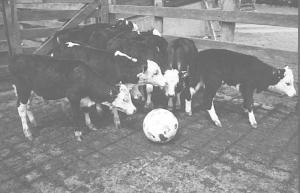1996 - Volume #20, Issue #3, Page #38
[ Sample Stories From This Issue | List of All Stories In This Issue | Print this story
| Read this issue]
Beach Balls Keep Livestock Happy
 |
Dr. Christian Cook, an animal scientist at a government research center, has been experimenting with putting big beach balls into cattle pens. You might say he's turning them into "playpens".
Cook says research has shown that stress in livestock can severely affect the production and quality of meat, resistance to disease and reproductive capability. "Children given a rich environment with lots of things to play with and explore do far better as adults when faced with stressful situations. The same applies to animals," says Cook who uses remote telemetry equipment to measure the benefits of play to cattle.
There are other aspects to reducing stress that Cook has identified. For example, he notes the benefits of keeping young animals together as a group. "Herds establish strong social linkages which tend to reduce stress. They don't like to be mixed with unfamiliar animals. It produces a lot of aggressive behavior. Instead of putting their energy into growth, they put it into fighting other animals."
By keeping animals happier, stress may be reduced when they're later transported to market. Cook straps telemetry units to the back of sheep and cattle to measure heart rates, electrocardiogram and body temperatures during transport. He notes that laws have already been introduced in Europe governing transport of animals and that it's only a matter of time before it becomes a concern worldwide. He says the agricultural community needs to discover ways to handle animals that cause less stress before solutions are forced upon them by the government.
(Story and photo courtesy Farm Equipment News, Auckland, New Zealand)

Click here to download page story appeared in.

Click here to read entire issue
To read the rest of this story, download this issue below or click here to register with your account number.




